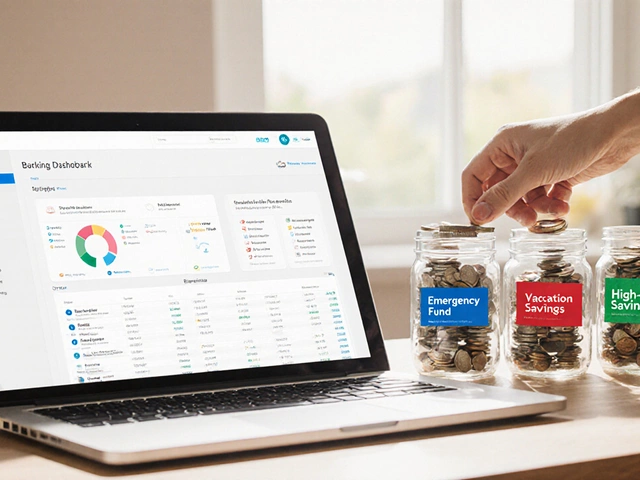
If you've got some money lying around in a savings account, you're probably hoping it's doing more than just sitting there. The truth is, where you stash your cash can make a big difference thanks to something called interest rates. It's like this magic percentage that can turn dollar bills into more dollar bills over time. Right now, some banks are offering pretty sweet deals when it comes to interest rates.
Sifting through banks to find who’s paying out the most can feel like finding a needle in a haystack. But that’s why we’re here. Because, seriously, who wants to spend hours combing through banking websites when you could be out there doing something fun, like convincing your kids, like Keegan, to finish their homework or planning the next family outing?
We've scooped up the latest info to share which banks currently offer the highest interest rates on savings accounts. From big names to smaller online players, we’ll look at the leaders in the game and what they’re bringing to the table. Whether you’re a total newbie to this savings thing or pretty seasoned, knowing where to park your funds is crucial for maximizing your dough. Ready to see who’s on top?
- Why Interest Rates Matter
- Current Top Banks Offering Great Rates
- Factors Affecting Interest Rates
- How to Choose the Best Account for You
- Maximizing Your Savings
Why Interest Rates Matter
So, what’s the big deal with interest rates, anyway? Well, think of them as the VIP card for your money. The higher the rate, the more cash you’re stuffing into your pocket over time without lifting a finger. It’s essentially your money working hard for you, earning something called savings rates, which is super important when you’re trying to make the most of every dollar.
Here's the kicker: Not all banks are created equal in this game. Some will keep your interest barely above zero, while others offer rates that can actually make a difference. Why sit idly when you can actively boost your savings by just choosing a bank wisely? A best savings account can literally turn your spare change into a sweet reward.
“Choosing the right savings account can significantly impact your financial growth over time, as even a slight increase in interest rate compounds into larger returns,” says Jane Bryant Quinn, a personal finance expert.
Now, a few things affect these savings rates. The economy plays its part – surprise, surprise! Generally, when the economy's doing a dance, interest rates might go up so banks can entice more people to save. Here’s an insider tip: keep an eye on economic trends because they can signal shifts in these rates!
To make this more tangible, let’s break it down with a quick illustration: Imagine you've got $10,000 lying in a savings account. At a measly 0.1% interest, that's only 10 bucks after a year. But with a 2% rate? You're looking at $200. See how that adds up?
So, paying attention to which banks offer the highest interest can be a total game changer for your financial future. It's all about finding the bank interest rate that clicks with your goals. Don’t let your money nap in an account that’s not doing its fair share of the lifting!
Current Top Banks Offering Great Rates
So, you're on the hunt for the best interest rates. It's not just about stashing cash; it's about making it work harder for you. As of 2025, here’s a snapshot of some banks that are really stepping up their game in offering juicy rates.
First off, you've got Ally Bank, a favorite for tons of savers looking for something enticing totally online. They're churning out a savings account interest rate around 3.75%, making them a solid contender. Old-school banks might not even come close!
Then there’s CIT Bank, which has a Premier High Yield Savings account you might want to check out. With rates hovering at about 4.00%, they're definitely catching eyes, especially for those who are serious about growing their money fast.
For anyone leaning towards a credit union vibe, Alliant Credit Union could be your go-to. They’re currently offering around 3.10% APY. While that might not sound like a top-tier number at first glance, credit unions often bring perks that bigger banks don’t.
You can't forget about Discover Bank either. Not only are they a big name, but they're dishing out a savings rate around 3.20% APY, which isn’t too shabby for a bank that's been around the block.
Here's a quick comparison to make spotting your top pick easier:
| Bank | Interest Rate (APY) |
|---|---|
| Ally Bank | 3.75% |
| CIT Bank | 4.00% |
| Alliant Credit Union | 3.10% |
| Discover Bank | 3.20% |
Choosing between these might come down to personal preference and what catches your eye. The key here? Whatever you do, don’t just let your money idle in a low-yield account when high rates like these are just a bank away!

Factors Affecting Interest Rates
So, you're probably wondering why some banks pay more interest than others. It's not like they're throwing darts at a board. There are quite a few things that get mixed into the interest rate stew. It might seem a little like wizardry at first, but it's all about simple economics and bank strategies.
First up, the big boss—central bank rates. When the Federal Reserve or another central bank tweaks their rates, it's like setting the mood for savings accounts everywhere. If they decide rates go up, banks tend to follow suit, and bam! Higher interest rates for you. But if they cut rates, it's like watching water go down the drain—your interest earning potential could sink.
Another factor is competition between banks. Yep, just like pizza places trying to outdo each other with crazy toppings, banks want to lure in customers with more attractive rates. If one bank boosts their rates, others might join the party to stay in the game and grab your attention.
Then there’s the economic climate. Pretty much everything ties back to how the economy is doing. During rough patches, banks might tighten their belts. Good times? They could be more generous with rates.
- Inflation: When prices rise, banks might offer higher rates to help account holders keep up.
- Loan Demand: If there's a high demand for loans, banks may offer better savings rates to gather more deposits to lend out.
- Risk Appetite: Some banks, especially newer online ones, might take bigger risks on rates to attract customers.
Check this out—a table comparison of average bank savings interest rates over the past year:
| Month | Average Rate (%) |
|---|---|
| January | 0.55 |
| April | 0.68 |
| July | 0.60 |
| October | 0.75 |
| December | 0.70 |
So, it's not just about which bank has the highest rates today. Understanding these factors can help you predict which bank might be best tomorrow, and that’s just as important. Keep these in mind when hunting for that next big interest rate score.
How to Choose the Best Account for You
Figuring out which savings account is your best bet can feel a bit like a choose-your-own-adventure game. But don't worry; we’ll help map out your path. The first thing is understanding what matters most to you. Is it all about nabbing the highest interest rates? Or maybe you want an account that won’t nickel-and-dime you with fees.
Here’s a simple breakdown to guide your decision:
- Interest Rates: Obviously, the higher, the better. But double-check if there are any hidden rules, like minimum balances required to earn that rate.
- Fees: No one likes fees, right? Some accounts may want to charge for things like maintenance or excessive withdrawals. Look for accounts with zero or low fees.
- Accessibility: Think about how often you’ll need to access your money. If it’s all the time, you might want a bank with great online banking or nearby ATMs.
- Account Minimums: Keep an eye on minimum balance requirements. Accounts with high rates might demand a hefty starting deposit.
- Customer Service: Ever been stuck on hold forever? Not fun. Check out customer service reviews; they might save you a headache later.
Sometimes, banks offer bonus rates or promotional deals for opening a new account. While these can be tempting, ensure that the long-term rates will still work for you after those offers expire.
And if comparing numbers gets too tangled, you can always create a simple chart to stack up your options side by side. Remember, choosing an account is personal. The best one for you depends on your habits and needs, so consider those before making your pick. Happy saving!

Maximizing Your Savings
Alright, now that you've parked your money in an account with the highest interest rates, how do you squeeze out even more value from those savings? There are a few strategies you might not have thought of yet!
First, make sure you’re aware of any account requirements to snag those top-tier rates. Banks sometimes have conditions like maintaining a minimum balance or setting up direct deposits. Not meeting these could yank down your rate.
Consider setting up automatic transfers from your checking account to your savings. That way, saving becomes a no-brainer and you can grow your balance without lifting a finger.
Keep an eye on rates. They fluctuate and what’s best savings accounts today might not be the same next year. It pays to stay informed and be ready to move your money to capitalize on new offers. Quick example: some savvy savers managed to increase their earnings by switching banks twice last year, effectively doubling their interest!
If you have a significant chunk in your savings, think about setting up a ladder strategy. It involves spreading your deposits across accounts with different maturity dates to capitalize on potentially higher rates while keeping parts of your funds accessible.
- Assess switching to online banks or credit unions: They often boast higher rates compared to their brick-and-mortar cousins.
- Investigate setting up a high-yield checking account to complement your savings for more interest earnings.
- Consider regular account health-checks: Review statements to catch any fees or rate changes you weren't expecting.
Lastly, those small amounts matter. Every time you get a windfall—be it a birthday gift or cash bonus—tuck a part of it into your savings. Over time, these little deposits, paired with highest interest rates, really accumulate.






Write a comment